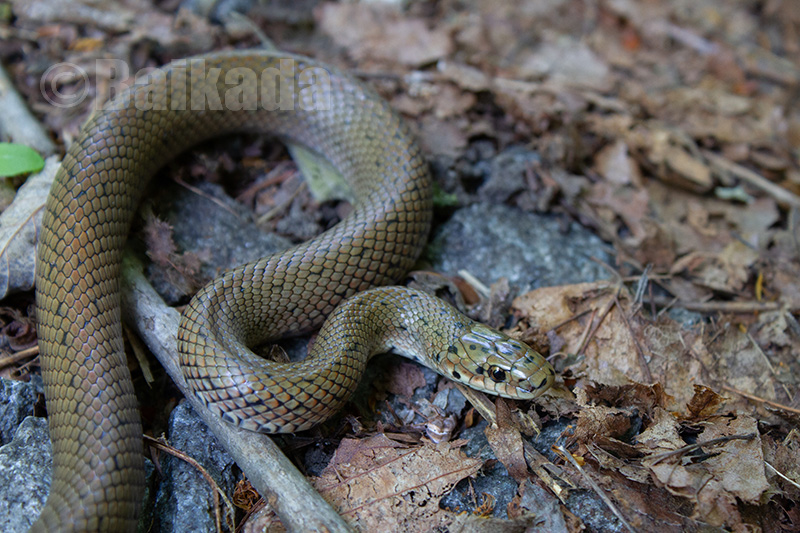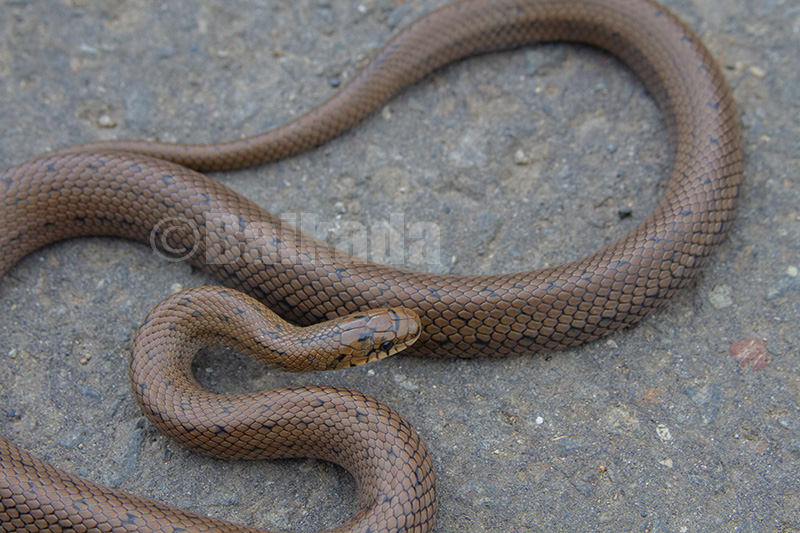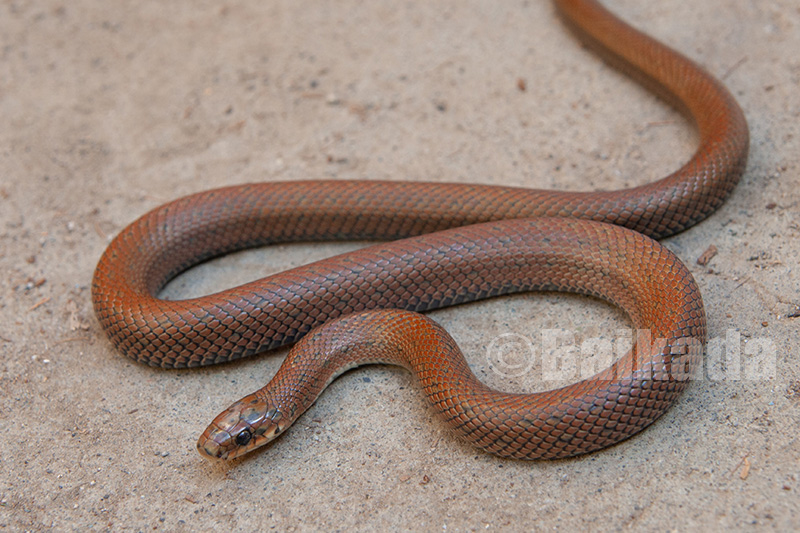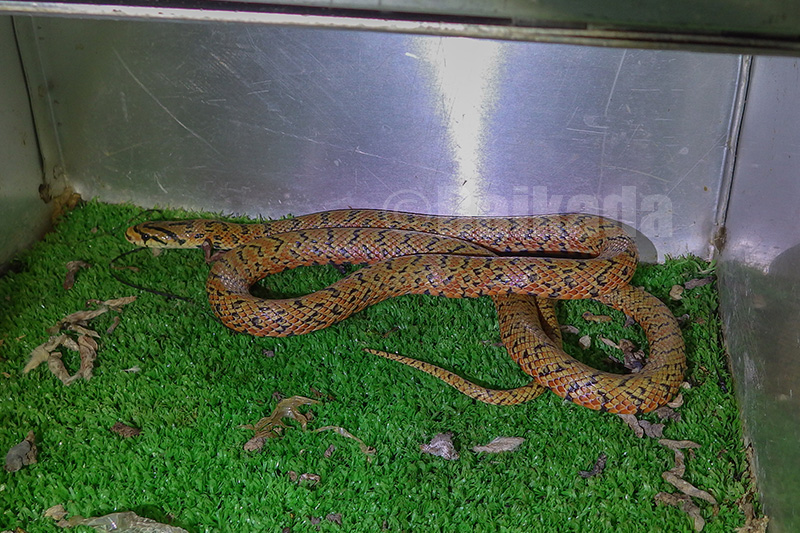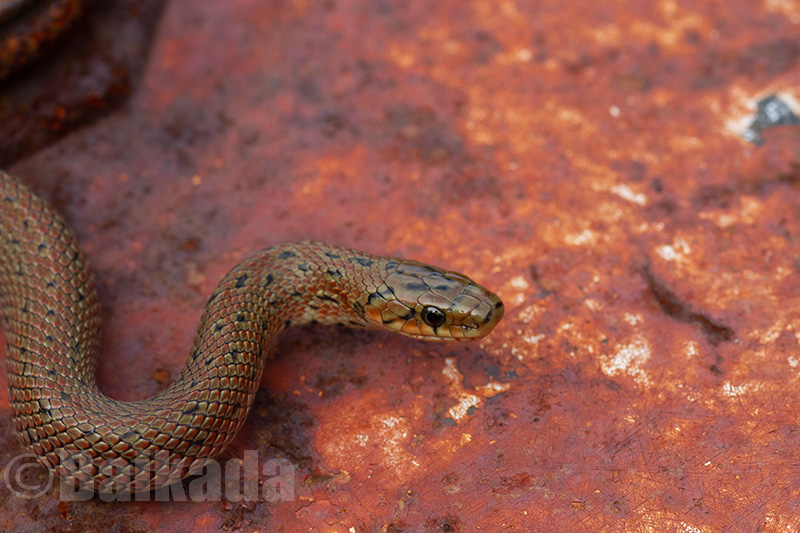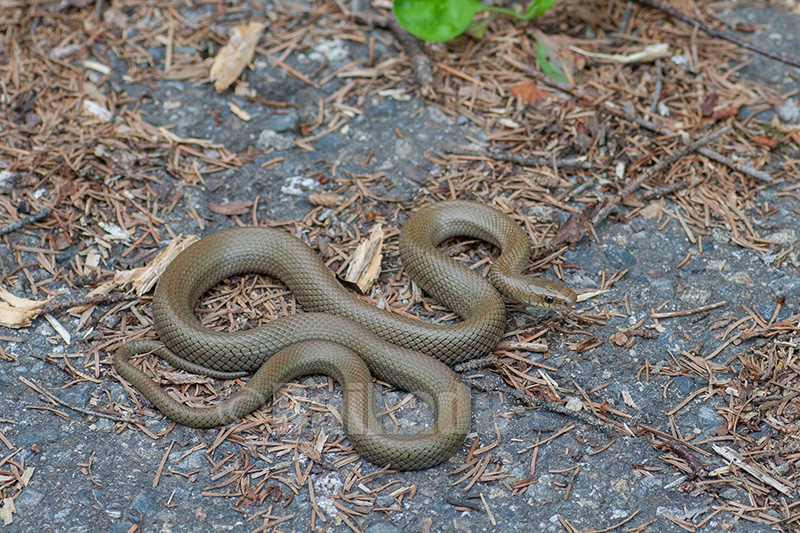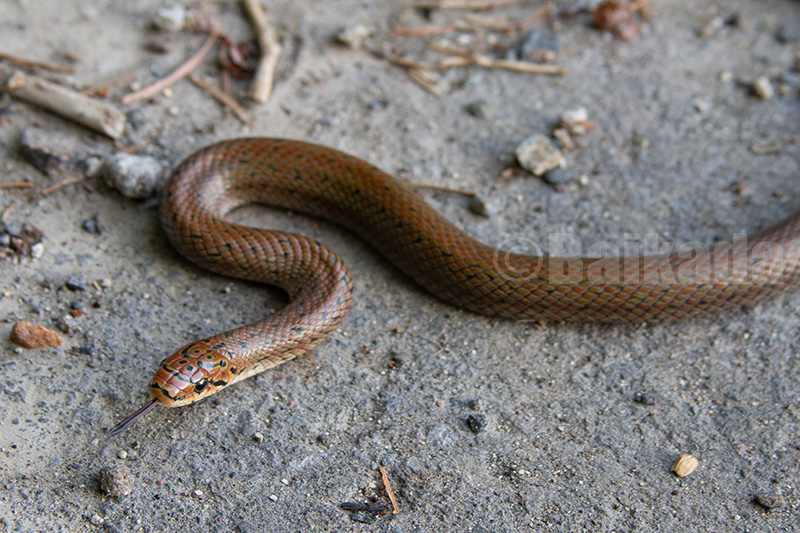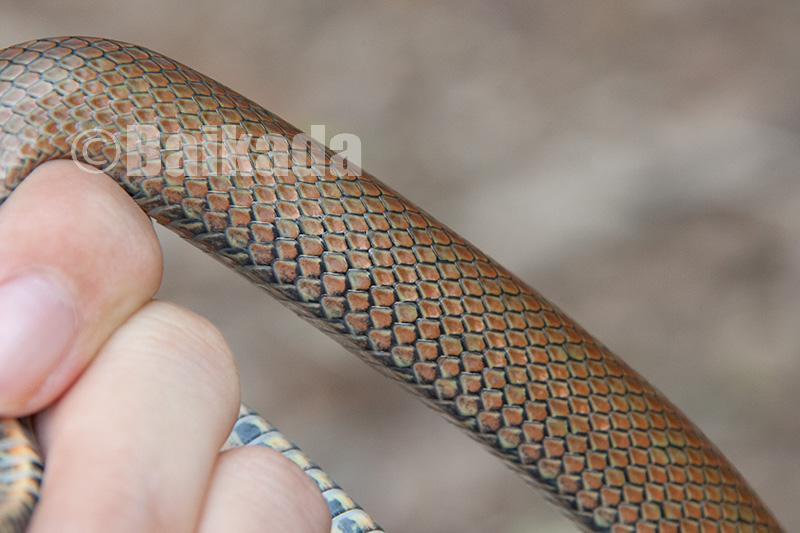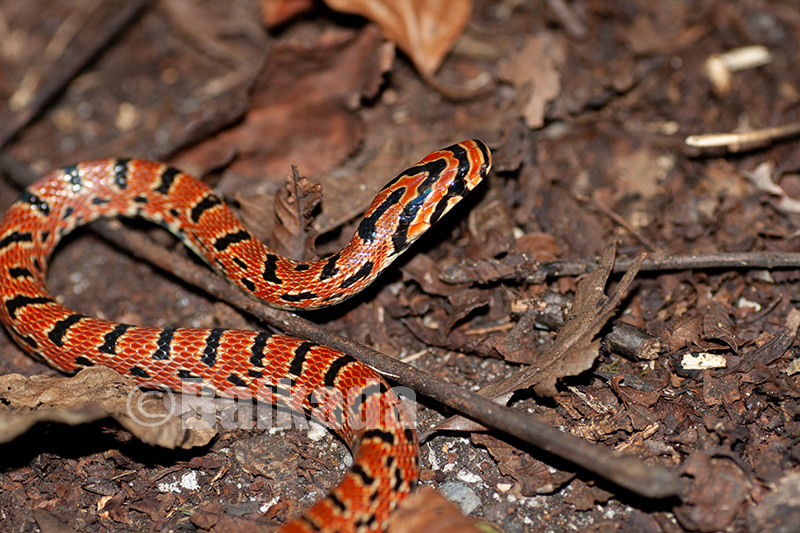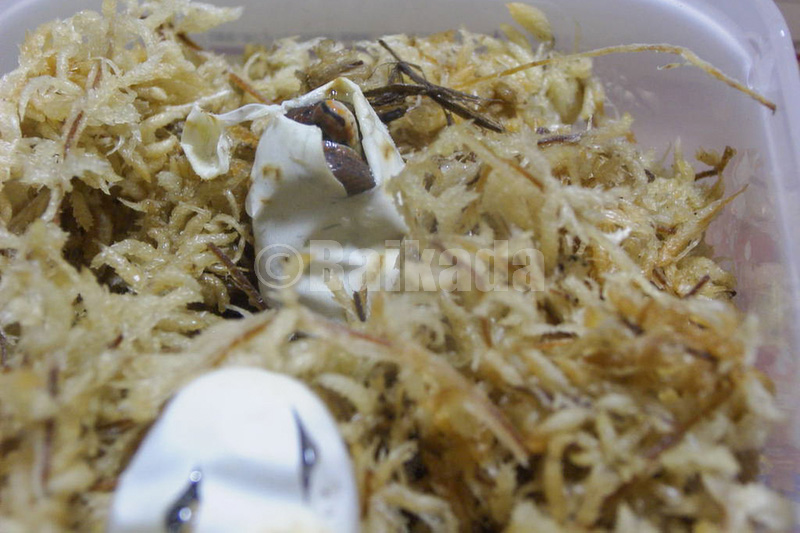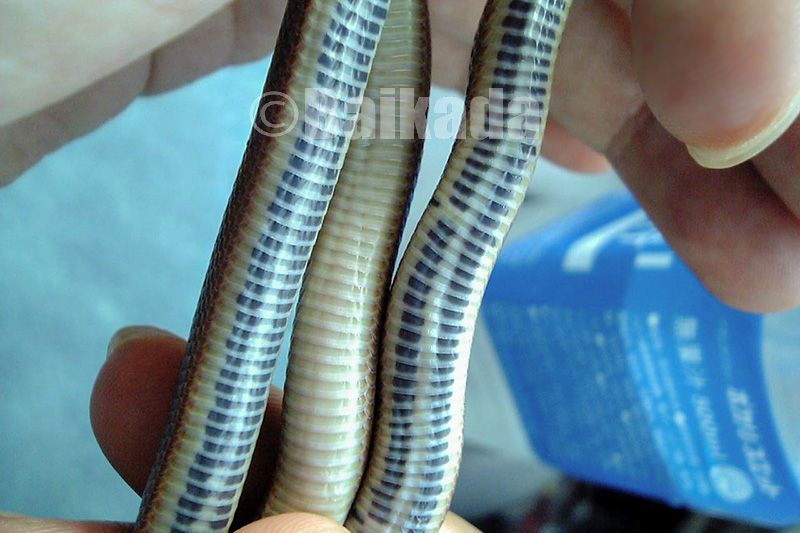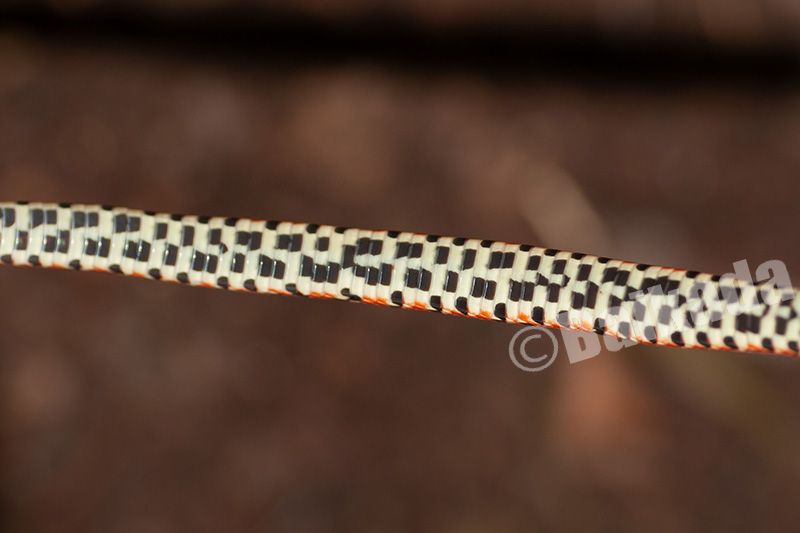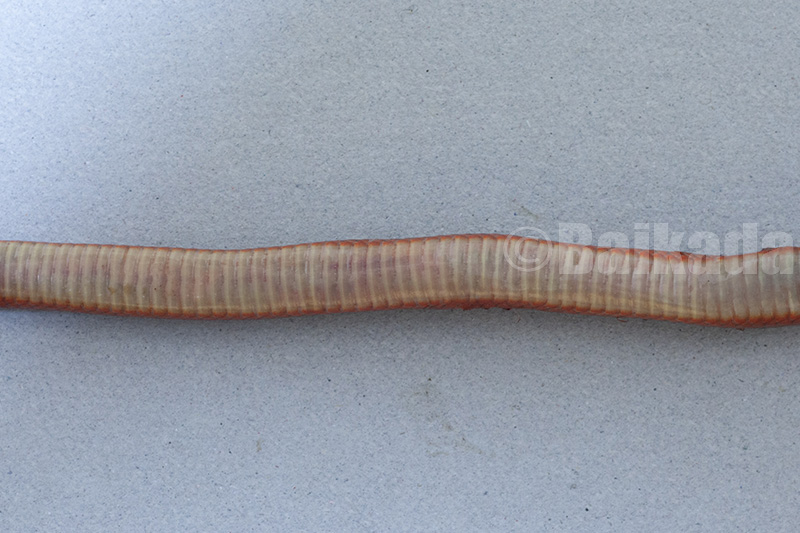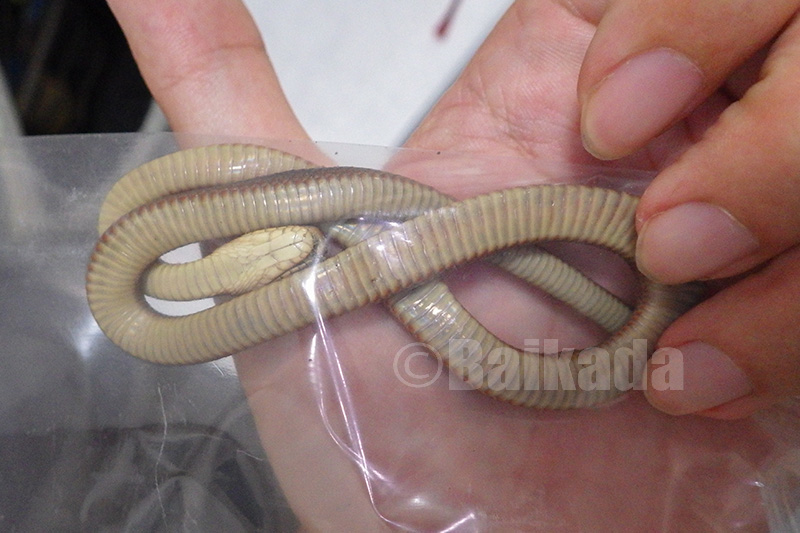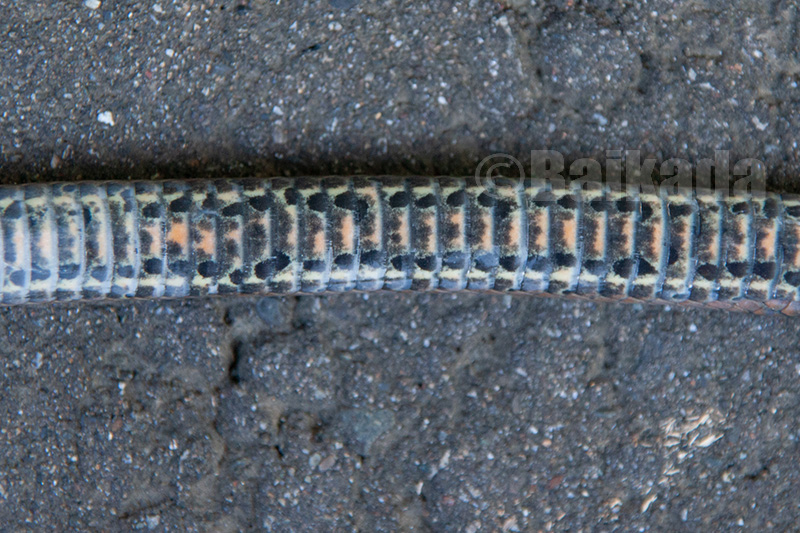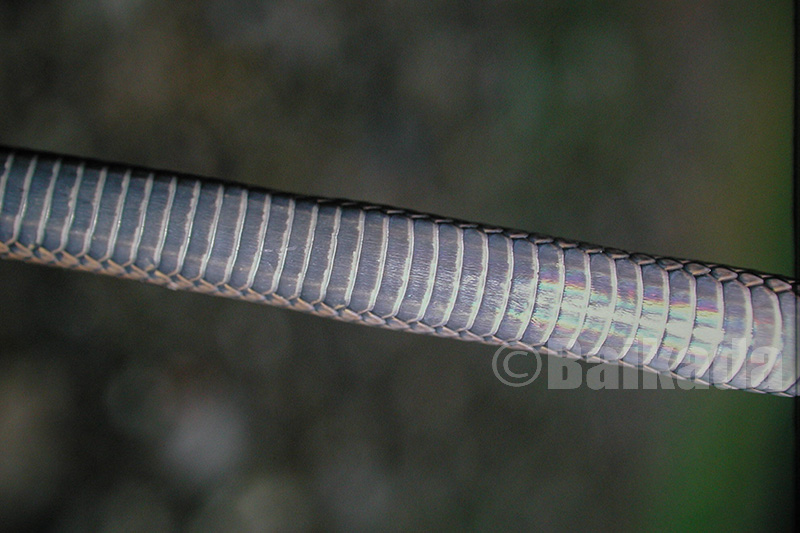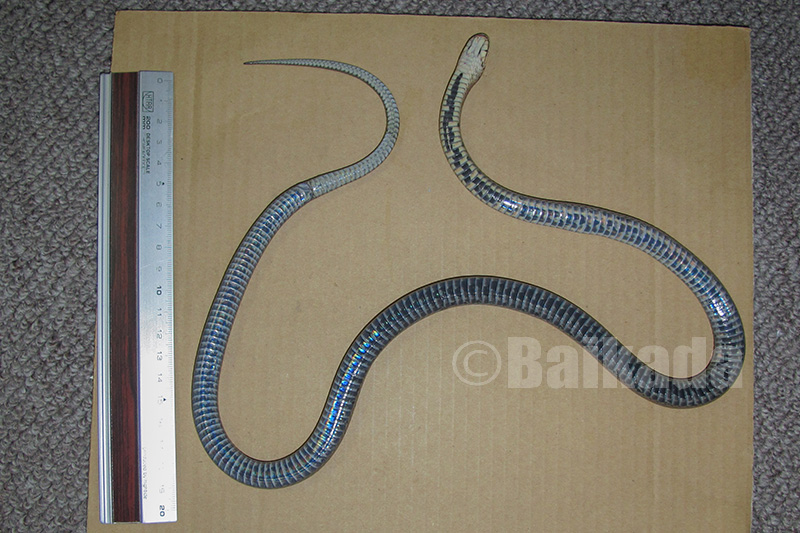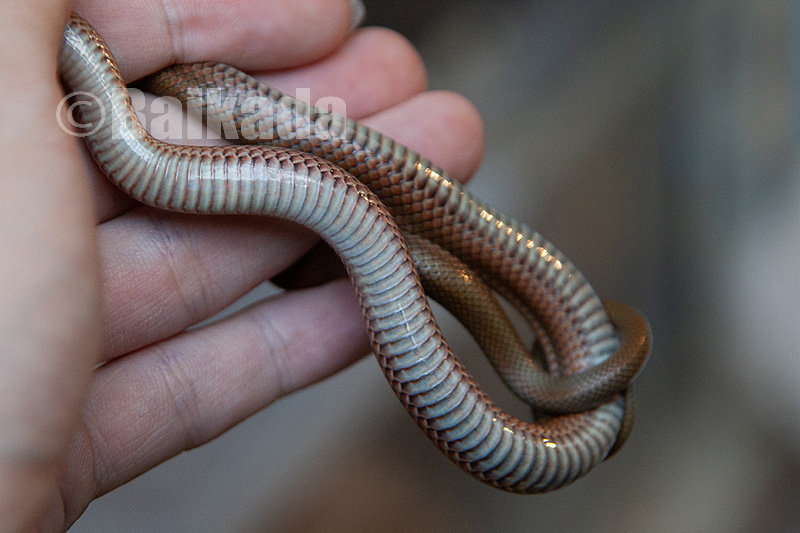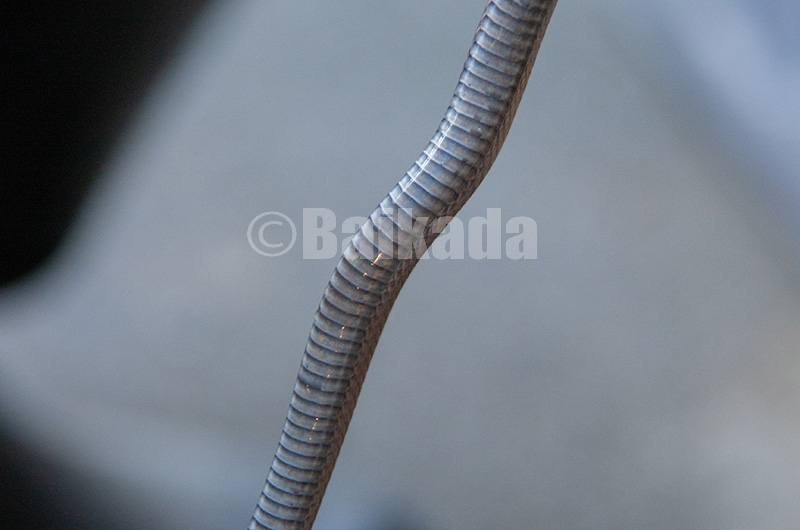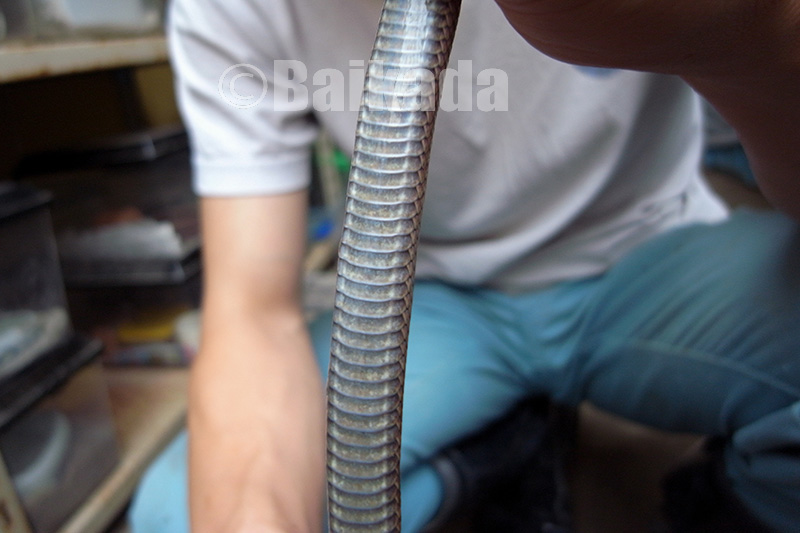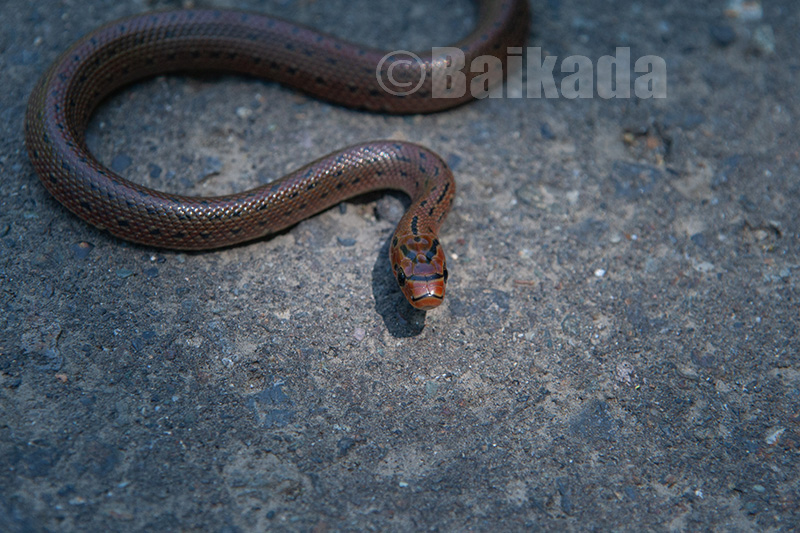*The highlighted portions of the text are subjective opinions based on the author’s experience. Please be careful if you refer to this.
*ハイライトの部分は著者の経験による主観なので、引用する場合は注意して下さい。
Japanese name(和名):
ジムグリ(地潜)/ Jimuguri
English name(英名):
Japanese wood-snake / Japanese forest rat-snake / Burrowing rat-snake
Scientific name(学名):
Euprepiophis conspicillata
At Hokkaido. Photo:Baikada
北海道札幌市産. 撮影:ばいかだ
At Hokkaido. Photo:Baikada
北海道札幌市産. 撮影:ばいかだ
北海道・本州・四国・九州・国後島・伊豆大島・佐渡島・隠岐・壱岐・屋久島・種子島。
Hokkaido, Honshu, Shikoku, Kyusyu, Kunashiri island, Izu Island, Sado Island, Iki island, Oki island, Yakushima island, Tanegashima island.
全長70~100cm。鼻先が丸く、基本的に上唇が下唇を覆う。これは土中を前進する際に土が口の中に入らないようにするための進化だと言われる。首のくびれは無い。虹彩は褐色。背面は淡黄褐色から淡赤褐色で、黒い小斑点が散在し、頭部には数本の黒条が入る個体もいる。成熟すると小斑点は黒条は目立たなくなる傾向がある(中には老齢でも黒条が残る個体もいる)が、北海道や本州以南の高地産の個体では若くても斑点を持たないものもいる。背面頸部から胴部にかけて、薄い暗縦条を持つ個体も時に見られるが、その縦条の境界は非常に不明瞭である(脱皮前の徴候の可能性がある)。
また褐色味や赤味の強い個体が北海道や本州以南の高地では見られる。体背面の赤みが強く、斑紋がなく、腹板は市松模様が一切なく白色をしているものを俗に「アカジムグリ」と呼ぶことがある。「アカジムグリ」は過去に別種として記録されていたこともあるが、現在の見解では色彩変異の一つであり、別種とはしていない。
普通のジムグリの腹面の基色は白く、黒のチェッカー(市松)模様になっている(時に朱色も混じる)。なお北海道ではこの市松模様が1本ないし2本の縦の黒条になっているものも多い(仮に縦条型とする)。腹白型(いわゆるアカジムグリ型)は、腹部に斑紋がない。北海道の個体では皮膚色が成長とともに黒化するものが多いため、北海道の腹白型は幼蛇のうちは腹が白くても、成長に連れて黒く変色していく(腹黒型)。
こうして例を挙げると、腹板は識別のポイントになりづらいと思えるが、本州・四国・九州の平地の個体群は多くが市松模様の腹板を持つものが多いので、やはり他種との差は特徴的ではある(ニホンマムシを除く)。
タイプとしては、背面の色や模様より腹面の特徴(市松模様型・縦条型・腹白型・腹黒型)から分けておいたほうが統一感がある。(背面がアカジムグリでも腹面が市松だったり、背面がノーマルでも腹面が無紋だったりするため、いわゆるノーマルとアカジムグリだけではタイプ分けが難しい)
The total length is 70 -100 cm. The tip of the nose is round, and the upper lip covers the lower lip. The neck is not gotten thin. The iris is brown. The dorsal surface is light yellow-brown to light reddish brown with scattered black spots on the body and a few black streaks on the head, equal some individuals generally become thinner as they mature (some individuals remain black streams even in old age). From the dorsal neck down to the torso, some individuals have thin dark longitudinal stripes, but the borders of these stripes are very obscure (a possible before “shedding sign” ). Individuals with a strong brown or red color are found in the highlands of Hokkaido and Honshu. This type is sometimes called “Aka-jimuguri”, and the back of the body is reddish with no spots, and the belly is white without any checkered pattern. Individuals with a strong brown or red color are found in the highlands of Hokkaido and Honshu. This type is sometimes called ‘Aka-jimuguri,’ and the back of the body is reddish with no spots, and the belly is white without any checkered pattern. “Aka-jimuguri” has been recorded as a different species in the past, but in the present view is one of the color variations and not a different species. The belly of the common type has a checkered pattern of white, black and vermilion. Many individuals in Hokkaido have a black stripe (one or two stripes) on their belly. In the case of “Aka-jimuguri” type from Hokkaido, their bellies are white, but they turn black as they grow.
At Hokkaido. Photo: Baikada
北海道札幌市産, 撮影:ばいかだ
Slightly red individual.
少し赤い個体。頭部や背部頂点に斑紋が少し残る
At Hokkaido. Photo: Baikada
北海道北見市産, 撮影:ばいかだ
A fairly red individual.
赤みの強い個体。頭部に斑紋が少し残るが、体部には斑紋がほとんどなく皮膚(鱗の隙間)が黒い。
At Gunma. Photo: Baikada
群馬県産(飼育個体), 撮影:ばいかだ
Individuals with juvenile pattern.
幼体時の斑紋が強く残る若い個体。本州産では成長後でも幼体時の模様がうすく残るものも少なくない。
撮影協力:日本蛇族学術研究所(ジャパンスネークセンター)
At Hokkaido. Photo: Baikada
北海道北見市産, 撮影:ばいかだ
“Aka-jimuguri” type. (But Belly was black.)
いわゆる「アカジムグリ」タイプ(ただし腹板が黒くなってきている)の若い個体。背面に斑紋は見られない。
At Hokkaido. Photo: Baikada
北海道鹿追町産, 撮影:ばいかだ
A individual that has no spots and is not reddish in body color.
斑紋がなく、体色も赤みがない個体
At Hokkaido. Photo: Baikada
北海道陸別町産, 撮影:ばいかだ
Individuals without body markings but with some dark streaks on their faces.
体の斑紋はないが、顔の暗条が少し残っている個体
At Hokkaido. Photo: Baikada
北海道札幌市産, 撮影:ばいかだ
An adult with juvenile pattern.
幼体の斑紋が残る成体
At Hokkaido. Photo: Baikada
北海道鹿追町産, 撮影:ばいかだ
A distinctive figure its neck constriction is inconspicuous.
頸部のくびれは目立たない独特な体型
At Hokkaido. Photo: Baikada
北海道札幌市産, 撮影:ばいかだ
The upper jaw covers the lower jaw. The front face is prettier than other snakes I can see.
上顎が下顎にかぶりこむ。正面顔は他の蛇より可愛く(?)見える
At Hokkaido. Photo: Baikada
北海道恵庭市産, 撮影:ばいかだ
Tongue color ranges from dark red to dark purple.
舌の色は暗赤色~暗紫色。
胴の中央部付近で21列。背面中央部(最も背骨寄り)の鱗には弱いキールがあるが、目立たない。
Body scales are 21 rows near the middle of the body. The scales in the middle of the back (closest to the spine) have weak keels but are not prominent.
At Hokkaido. Photo: Baikada
北海道札幌市産, 撮影:ばいかだ
Skin under the scales tends to darken in adults in Hokkaido. There is no keel on scales other than the dorsal midline.
鱗の下にある皮膚は、北海道の個体では成体は黒化する傾向。背面中央以外の鱗ではキールはない。
基本的に日中に地上及び半地中の生活をすると言われるが、夏季のように気温が上がる時期には早朝や夜間に行動するものも見られる。涼しい時期、時間帯に多く見られる。盛夏になるとと見かけにくくなる。(25℃あたりが限界か?)
It is generally said that they live on the ground and underground during the day. When the temperature rises, as in summer, many of them are inactive or active early in the morning or at night. It is often seen in the cool season or the cool time zone. You can’t see them when it gets hot. (Around 25 °C may be the limit for action.)
丘陵地から高地の森林や竹林に多い。ネズミやトガリネズミなどが多く生息する環境に見られる。河川敷の芦原などで見られることもある。
Many of them are found in forests and bamboo forests ranging from hilly areas to highlands. It is found in the environment where many mice and shrews live. It is sometimes seen in reed bed in the riverbed.
At Hokkaido. Photo: Baikada
北海道札幌市産, 撮影:ばいかだ
It is easy to meet on a forest road.
森林内の林道で出会いやすい。
ネズミ、ジネズミ、トガリネズミ、ヒミズなど。生まれたての幼獣のような小さな獲物を好む。モグラを絞めていた例もある(捕食は出来なかった模様)。
Mice, shrews, etc. They like small prey such as newborn juveniles. In one case, they constricted moles (it seems that they could not eat them because too big for prey).
背面が茶色~鮮やかな赤色で黒い小斑点(横帯状になる場合もある)がある。黒いラインが顔にかかり「くまどり」に形容されるような容貌であり、成体とはかなり雰囲気が違う。
Body color is brown to bright red on the back and black speckles (which may form horizontal bands). Juveniles have a black line on their faces, and their atmosphere is quite different from that of adults.
At Kyoto. Photo: Baikada
京都府産, 撮影:ばいかだ
Juvenile.
幼蛇
At Hokkaido. Photo: Baikada
北海道恵庭市産, 撮影:ばいかだ
In Hokkaido, juvenile snakes are less reddish and have smaller spots.
北海道では幼蛇の赤みが少なく、斑紋も小さい。
At Hokkaido. Photo: Baikada
北海道北見市産, 撮影:ばいかだ
“Aka_jimuguri” type has not had black spots since the time of the juvenile.
腹白型(アカジムグリタイプ)は幼蛇の頃から黒斑がない。
At Hokkaido. Photo: Baikada
北海道津別町産, 撮影:ばいかだ
Of the four juveniles that hatched after spawning, one was a white-bellied (“Aka_jimuguri”) type. All snakes were released at the capture place. (Photo taken just before release)
撮影のために捕獲したジムグリが産卵をし、孵化した4個体のうち、腹白型(アカジムグリタイプ)が1匹いた。親蛇も幼蛇も、捕獲地点でリリースした。(リリース直前の写真)
無い。
This snake does not have venom.
繁殖は4~6月に交尾し、7~8月に1~7卵を産む。
Breeding occurs from April to June with one to seven eggs laid.
At Hokkaido. Photo: Baikada
北海道津別町産の個体が産卵した卵, 撮影:ばいかだ
Eggs laid by captured individuals hatched.
捕獲した個体が産卵した卵が孵化した
自然状態の良い山に登れば比較的多く見られるが、平野部では多くない。日本固有種。IUCN版(世界版)Red-List Ver3.1でLeast Concernに選定されている。環境省レッドリストでは選定されていない。都道府県版のレッドリスト選定状況はこちら。市町村版のレッドリストで指定されている場合もあるので、注意してください。
Endemic to Japan and designated as a Least Concern by the IUCN Red-List Ver3.1.
比較的大人しい種類で咬みつかない個体が多いが、全てには当てはまらない。捕まえられる時には咬まなかったのに、手でいじられいるうちにイライラするのか、後になって咬んだのが何個体かいた。白腹型(アカジムグリ)は高緯度、高標高地域で見られる傾向があり、白腹のまま成長する本州高地産のものは大変美しい。
また同じ親から生まれた卵からアカジムグリとジムグリが生まれた報告や、私も、自宅で撮影のために捕獲したジムグリが産卵し、4卵のうち1匹が白腹型・残り3匹が縦条型だったこともあり、同じ親から白腹型と縦黒条型が生まれたため、別種とかではなく、単なる個体変異と考えられる。
At Hokkaido. Photo: Baikada
北海道津別町産の個体が産んだ仔, 撮影:ばいかだ
They were born from the same mother during the same egg-laying period. However, the patterns on each belly are different.
同腹仔ながら白腹型と縦条型が生まれた
At Kyoto. Photo: Baikada
京都府産, 撮影:ばいかだ
A checkered pattern on the belly.
市松模様(チェックパターン)の腹板。
At Hokkaido. Photo: Baikada
北海道札幌市産, 撮影:ばいかだ
Two vertical black-lines belly pattern.
縦条型(二本)
At Hokkaido. Photo: Baikada
北海道札幌市産, 撮影:ばいかだ
Two vertical black-lines belly pattern.
縦条型(二本)
At Hokkaido. Photo: Baikada
北海道札幌市産, 撮影:ばいかだ
A vertical black-line belly pattern.
縦条型(一本)
At Hokkaido. Photo: Baikada
北海道札幌市産, 撮影:ばいかだ
A checkered pattern on the belly.
市松模様(チェックパターン)の腹板。少し規則的。
At Hokkaido. Photo: Baikada
北海道札幌市産, 撮影:ばいかだ
A checkered pattern on the belly.
市松模様(チェックパターン)の腹板。黒斑が小さい。
At Hokkaido. Photo: Baikada
北海道札幌市産(死骸), 撮影:ばいかだ
The white belly pattern.
白腹型
At Hokkaido. Photo: Baikada
北海道釧路市産(死骸), 撮影:ばいかだ
The white belly pattern.
白腹型
At Hokkaido. Photo: Baikada
北海道札幌市産, 撮影:ばいかだ
Complex.
複雑なタイプ
At Hokkaido. Photo: Baikada
北海道北見市産, 撮影:ばいかだ
The black belly pattern.
黒腹型
At Hokkaido. Photo: Baikada
北海道札幌市産(死骸), 撮影:ばいかだ
The black belly pattern. Perhaps in the younghood, its belly was check pattern.
幼蛇の頃は市松模様型だったものが成長に伴い黒化したと思われるもの
At Hokkaido. Photo: Baikada
北海道北見市産, 撮影:ばいかだ
The black belly pattern. The ventral tail is white.
黒腹型でも、尾の腹側は白い。おもしろい。
At Hokkaido. Photo: Baikada
北海道北見市産, 撮影:ばいかだ
There are many cases in which the pattern is different in cervix and abdomen.
頚部と腹部でパターンが違うものも少なくない。
At Hokkaido. Photo: Baikada
北海道北見市産, 撮影:ばいかだ
In the following, the white-belly type from Hokkaido changes into the black-belly type as it grows in (1) to (6). ; (1)
以下、①~⑥で北海道産白腹型が成長に伴い黒腹型に変化する様子:①
At Hokkaido. Photo: Baikada
北海道北見市産, 撮影:ばいかだ
In the following, the white-belly type from Hokkaido changes into the black-belly type as it grows in (1) to (6). ; (2)
以下、①~⑥で北海道産白腹型が成長に伴い黒腹型に変化する様子:②
At Hokkaido. Photo: Baikada
北海道北見市産, 撮影:ばいかだ
In the following, the white-belly type from Hokkaido changes into the black-belly type as it grows in (1) to (6). ; (3)
以下、①~⑥で北海道産白腹型が成長に伴い黒腹型に変化する様子:③
At Hokkaido. Photo: Baikada
北海道北見市産, 撮影:ばいかだ
In the following, the white-belly type from Hokkaido changes into the black-belly type as it grows in (1) to (6). ; (4)
以下、①~⑥で北海道産白腹型が成長に伴い黒腹型に変化する様子:④
At Hokkaido. Photo: Baikada
北海道北見市産, 撮影:ばいかだ
In the following, the white-belly type from Hokkaido changes into the black-belly type as it grows in (1) to (6). ; (5)
以下、①~⑥で北海道産白腹型が成長に伴い黒腹型に変化する様子:⑤
At Hokkaido. Photo: Baikada
北海道北見市産, 撮影:ばいかだ
In the following, the white-belly type from Hokkaido changes into the black-belly type as it grows in (1) to (6). ; (6)
以下、①~⑥で北海道産白腹型が成長に伴い黒腹型に変化する様子:⑥
At Hokkaido. Photo: Baikada
北海道札幌市産, 撮影:ばいかだ
It is more likely to be seen in a place with sunlight through the trees than in a place with severe sunlight.
日射が厳しいところより、木漏れ日で日射のある場所の方が見かけやすい
注意
当ページは「へび図鑑」の1ページです。今後も新知見等出ましたら随時更新します。内容(画像を含む)の無断転記・転載は禁止です。使用する際には「ばいかだ」に一報し、サイト名(へび図鑑)、撮影者、引用URLを掲示してください。
撮影、説明の作成は、ばいかだ(徳田龍弘)が行いました。
Attention
This page is one of the pages of the “Snakes of Japan“. It will be updated as soon as new knowledge is found. The transcription and the reprint of the contents (including the image) without permission are prohibited. Please inform “Baikada” when you use it, and post the site name (Snakes of Japan), photographer, and quotation URL. Baikada (Tatsuhiro Tokuda) took the photograph and made the explanation.
